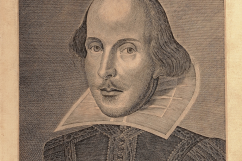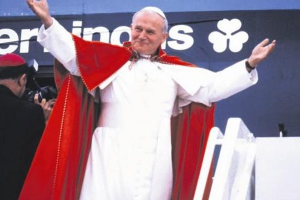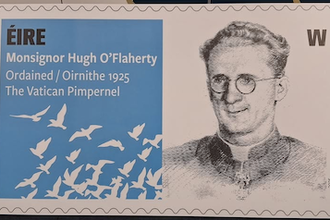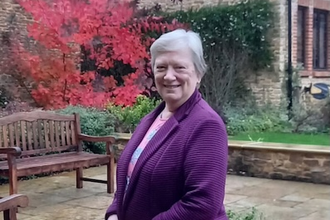The Christian Heritage Centre and St Theodore
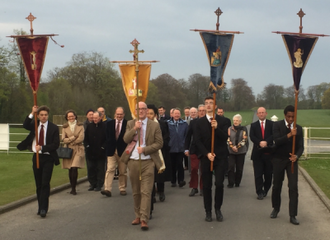
Procession on Feast of St Joseph the Worker
St Theodore, whose feast day is celebrated on September 19th , holds a special place in the hearts of Orthodox, Catholics and Anglicans. Born in Syria, he lived between 602 AD and 690 AD and was Archbishop of Canterbury from 668 AD until his death.
Derived from both Latin and Greek, the name Theodore means“God’s gift” – and, as St Theodore’s feast day approaches, the trustees of the Christian Heritage Centre have been reflecting on both God’s generous Providence and the life of a man who proved to be such a gift to English Christianity.
Perhaps best known for the way he reformed the Church in England, and for the priority which he gave to education, Theodore was a Syrian Christian of Byzantine descent, who was forced to flee from Tarsus, when it fell to Islam. His own story is especially poignant as today’s Syrian Christians face their own Calvary of genocide, sustained persecution, and flight to unknown lands.
His story reminds us of the ever-present challenge of persecution and the exodus of the Middle East’s Christians fleeing Syria and Iraq.
St Theodore studied theology, medicine, Roman Civil Law, Greek rhetoric and philosophy, Latin literature (both secular and ecclesiastical), astronomy and mathematics in Antioch, Constantinople and Rome. He was the embodiment of faith and reason.
When Pope Vitalian sent Theodore to Britain it was just after the Synod of Whitby had, in 667 AD, confirmed the decision of the English Church to follow Rome. But this was a difficult time for the Church in England – with conflict between bishops such as Wilfrid and Chad.
On arriving in England, as the eight Archbishop of Canterbury, Theodore immediately embarked on a tour of the country tackling abuses and confronting the seventh century’s warring factions.
He instructed Chad to stand down as a bishop and appointed Wilfrid in his place. Yet Theodore also saw, in Chad’s obedience, holiness, and humility, a man of God. He returned Chad to his post as abbot of Lastingham – and later as Bishop of the Mercians.
Today, Theodore, Wilfrid and Chad are each remembered as saints of the Church.
Objects like St Chad’s relics – and those of St.Thomas Becket -martyred and assassinated at Canterbury in 1170 AD – are held on behalf of the Society of Jesus at the Stonyhurst Christian Heritage Centre.
They are objects with a purpose and their own preservation tells its own story.
In Chad’s case, some of his relics were hidden from Henry VIII’s desecrations and kept by the Dudley family of Lichfield. Later passed to a Sedgley farmer, Henry Hodgetts, a Jesuit priest, Fr.Peter Turner SJ, asked Hodgetts why, on his death bed, Hodgetts kept seeking the intercession of St.Chad. He told Fr Peter that it was“because his bones are in the head of my bed.”
The dying Hodgetts told his wife to give the relics to the priest who in turn took them to St Omer, the future Stonyhurst. Many of the relics would ultimately return to England and to Pugin’s Cathedral of St.Chad in Birmingham.
Why do these stories matter?
Because, in the twenty first century, the challenge for Britain is to overcome its increasing loss of memory – and to recall again its Christian story and Christian heritage.
Collective amnesia is affecting the way in which the nation thinks and acts. You are in deep trouble when you forget what makes you who and what you are. Isaiah said you should always “remember the rock from which you were hewn, the quarry from which you were dug.”
In so many diverse ways Theodore speaks into our own times.
He is celebrated for healing divisions, reforming the Church and for the entrenchment of Christian education. His promotion of Biblical commentary, sacred music, knowledge of Eastern Christianity - and the possible creation of the Litany of the Saints - added richness and beauty to the liturgy and a more profound understanding of other traditions within the Christian faith. A saint, then, for our troubled times.
Last year, when the Theodore Trust was wound up, its trustees generously decided to transfer their remaining funds into the Christian Heritage Centre project, a freestanding registered charity which - blessed by a fruitful partnership with Stonyhurst College - enabled Phase Three of the project to go ahead.
Other generous benefactors include The Knights of Columbus, The Leverhulme Trust,The Bowland Trust, the Liverpool Archdiocese and Kim and Ben Chang.
These donations are transforming an old ruined Victorian mill (a Grade Two listed building) that, for years, has stood roofless and decaying.
Next summer, when the work has been completed, Theodore House will have rooms for 34 people - enabling individual, parish and school visits to see the historic Collections and to explore the walks of JRR Tolkien and Gerard Manley Hopkins – who were both inspired by the beautiful surroundings of Lancashire’s stunningly beautiful Ribble Valley.
Abutting the mill are the disused kennels which were home to the hounds that may have inspired a young student, Arthur Conan Doyle, who studied there, between 1869 and 1875, to write his Hounds of the Baskervilles.
Doyle’s description of the fictional Baskerville Hall bears an uncanny likeness to the view from Theodore House: “The Avenue opened into a broad expanse of turf, and the house lay before us. In the centre was a heavy building from which a porch projected.... from this central block rose the twin towers, ancient, crenelated, and pierced with many loopholes.”
Two of Doyle’s contemporaries had the name Moriarty. So, it’s “elementary, my dear Watson!" from Sherlock to Bilbo Baggins, from saints to scholars, from prayer to reflection, a visit to Theodore House will refresh the spirit and open the mind.
And work is now well under way.
On May 1st, celebrating the feast of St Joseph the Worker and the month of the Blessed Mother, an early morning procession with banners, culminated at the mill.
Perhaps underlining the international importance of both the Collections and the mission of Theodore House the procession was led by Mexican student, and Stonyhurst’s new Head of Line, Nicolas Mariscal Palacio. A Jesuit priest, Fr John Twist SJ, blessed the building, and those construction workers who would work on transforming it into Theodore House.
Theodore House will also provide visitors, students and retreatants with study space, seminar and lecture rooms and a chapel.
The oratory will be dedicated to two of the great Christian saints of the twentieth century – Mother Teresa of Calcutta and Pope John Paul II. Fundraising is also underway to place contemporary forms of the Stations of the Cross –“the Northern Stations” – in the grounds of Theodore House, representing theVia Crucis of those whose lives are destroyed or maimed on their own modern day Calvaries.
And, if more donations are received, there is space for an annexe for families with children.
In addition to enabling access to the Collections of 60,000 objects and 50,000 volumes of enormous Catholic importance the Christian Heritage Centre will host a Collegium programme and opportunities for Christian Leadership formation.
Burma’s Cardinal Bo visits the museum in Phase Two of the Christian Heritage Centre.
This is the oldest surviving museum collection in the English-speaking world. The cultural significance of the objects in the Collections transcends national boundaries and is of common importance for present and futuregenerations of many peoples and nations. Underlining the international importance of this initiative, the patrons of the project include its Royal Patrons, Lord and Lady Nicholas Windsor; Field Marshall Lord Guthrie, the former head of the UK’s armed forces; John Bruton, the former Irish Prime Minister; Baroness Cox and the Rt Hon Ann Widdecombe.
The project is a Registered Charity with Royal Patronage.
Theodore House will facilitate programmes for people of all ages and cultures, promoting dialogue, tolerance, and mutual respect at a time when the world is witnessing a tragic resurgence of religious conflict – using the Collections to reflect more deeply on questions of faith, identity, religious freedom, persecution and tolerance. There are plans for Summer Schools and Festivals (with accommodation for up to 400, outside of term time).
All of which would surely have appealed to St Theodore.
If alive today he would have carefully studied a recent survey that found that the number of people identifying as Christians in the UK is around 64% but that, on present trends, this number will fall to 45% by 2050. The proportion of Muslims would rise over the same period from 5% to 11% and the number of atheists or people claiming no religion would rise from 28% to 39%.
The statistics tell their own story and indicate the scale of the challenge – but also the opportunity which living in a free society still offers. Theodore would put his faith in God and set out to do something about it. But will we?
In celebrating his coming Feast Day, the trustees of the Christian Heritage Centre hope that Theodore House, named for him, will play its part in renewing the Christian foundations of our nation. Please help.
For more information see: www.christianheritagecentre.com/
and Facebook: www.facebook.com/ChristianHeritageCentre
Contact Anton de Piro at: anton@christianheritagecentre.com
This article was published in the Universe and has been reprinted here with permission of Lord Alton.




